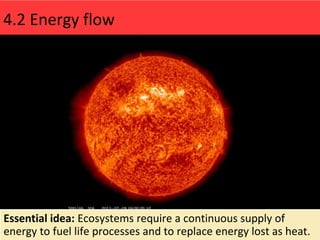
4.2 energy flow
- 1. Essential idea: Ecosystems require a continuous supply of energy to fuel life processes and to replace energy lost as heat. 4.2 Energy flow
- 2. Understandings, Applications and Skills Statement Guidance 4.2 U.1 Most ecosystems rely on a supply of energy from sunlight 4.2 U.2 Light energy is converted to chemical energy in carbon compounds by photosynthesis 4.2 U.3 Chemical energy in carbon compounds flows through food chains by means of feeding. [Pyramids of number and biomass are not required. Students should be clear that biomass in terrestrial ecosystems diminishes with energy along food chains due to loss of carbon dioxide, water and other waste products, such as urea.] 4.2 U.4 Energy released from carbon compounds by respiration is used in living organisms and converted to heat. 4.2 U.5 Living organisms cannot convert heat to other forms of energy. 4.2 U.6 Heat is lost from ecosystems. 4.2 U.7 Energy losses between trophic levels restrict the length of food chains and the biomass of higher trophic levels. [The distinction between energy flow in ecosystems and cycling of inorganic nutrients should be stressed. Students should understand that there is a continuous but variable supply of energy in the form of sunlight but that the supply of nutrients in an ecosystem is finite and limited.] 4.2 S.1 Quantitative representations of energy flow using pyramids of energy. [Pyramids of energy should be drawn to scale and should be stepped, not triangular. The terms producer, first consumer and second consumer and so on should be used, rather than first trophic level, second trophic level and so on.]
- 3. 4.2 U.1 Most ecosystems rely on a supply of energy from sunlight An open system makes it possible of maintain a stable ecosystem, with a lose of 90% of all the energy input. Due to the Sun’s constant supply of energy back into the system. Energy is an open system on Earth
- 4. Sunlight is the initial energy source for almost all communities • Energy flows through the food chain, being lost at each stage due to respiration. 4.2 U.1 Most ecosystems rely on a supply of energy from sunlight
- 5. 4.2 U.2 Light energy is converted to chemical energy in carbon compounds by photosynthesis • The process by which plants, autotrophic light energy (photons) to make sugars and other organic food molecules from carbon dioxide and water
- 6. 4.2 U.3 Chemical energy in carbon compounds flows through food chains by means of feeding Chemical energy in carbon compounds flows through food chains by means of feeding. •1º consumers feed on the producers. Only around 10%-20% of the energy from the producer is passed on to the 1º consumers. The rest of the energy islost as heat through cell respiration, death and waste. •2º consumers feed on the 1º consumers. Again only 10%-20% of the energy is passed on to the next level, with the rest lost as heat through respiration, death, and waste. •3º consumers feed on 2º consumers. 10%-20% is passed on to the tertiary consumer and the rest is lost as heat, death and waste.
- 7. 4.2 U.4 Energy released from carbon compounds by respiration is used in living organisms and converted to heat. • Organisms need cellular energy for cellular activities (MR. H GREN) • ATP provides the energy needed for these cellular activities • ATP is produced through cellular respiration, is an exothermic (heat is produced as a waste product) and the energy released is used in endothermic phosphorylation reactions to create ATP. • ATP can be used quickly for the cellular activities listed above. • These reactions 38% efficient, therefore some of the energy produced in these oxidation reactions is lost as heat. • *Burning gas in your car to move it is about 25% efficient
- 8. 4.2 U.5 Living organisms cannot convert heat to other forms of energy. • Organisms can perform a variety of energy conversions, such as light to chemical energy during photosynthesis, chemical energy to KE during muscle contractions, chemical energy to electrical energy in nerve impulses and chemical energy to heat energy in heat-generating adipose tissue • Organisms cannot turn heat energy into any other forms of energy
- 9. 4.2 U.6 Heat is lost from ecosystems • Heat resulting from cellular respiration makes an organism warmer. Cold-blooded organisms can become more active, while warm blooded animals can increase their rate of heat generation in order to maintain their in internal body temperature • Eventually though, since heat passes from warmer to colder bodies, all heat is lost from the ecosystem
- 10. Energy Flow Through Ecosystems 4.1 U.7 Energy losses between trophic levels restrict the length of food chains and the biomass of higher trophic levels.
- 11. Energy Pyramid • The greatest amount of energy in a community is present in the organisms that make up the producer level. • Only a small portion of this energy is passed on to primary consumers, and only a smaller portion is passed on to secondary consumers (on average, only about 10% of the energy). • A pyramid of energy can be used to illustrate the loss of usable energy at each feeding level. 4.2 S.1 Quantitative representations of energy flow using pyramids of energy.
- 12. Pyramids of energy • Show the flow of energy between trophic levels • Measured in units of energy per unit area per unit time. KJ m-2 y-1 • The transfer of energy is never 100% efficient 4.2 S.1 Quantitative representations of energy flow using pyramids of energy.
- 13. THE 10% RULE and ECOLOGICAL PYRAMID 4.2 S.1 Quantitative representations of energy flow using pyramids of energy.
- 14. Trophic Levels Notice that only 10% is moved to the next level. Where does the rest go? 4.2 S.1 Quantitative representations of energy flow using pyramids of energy.
